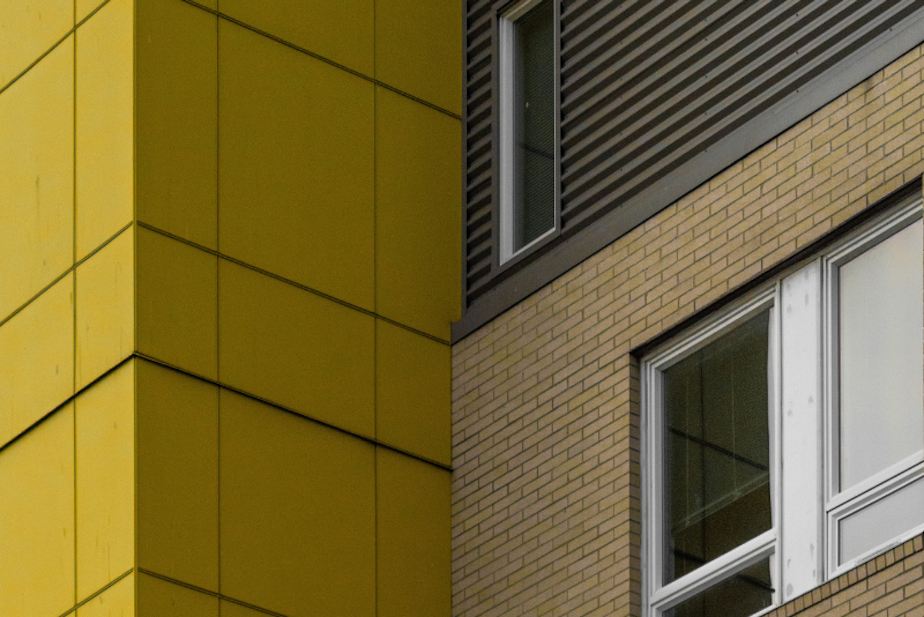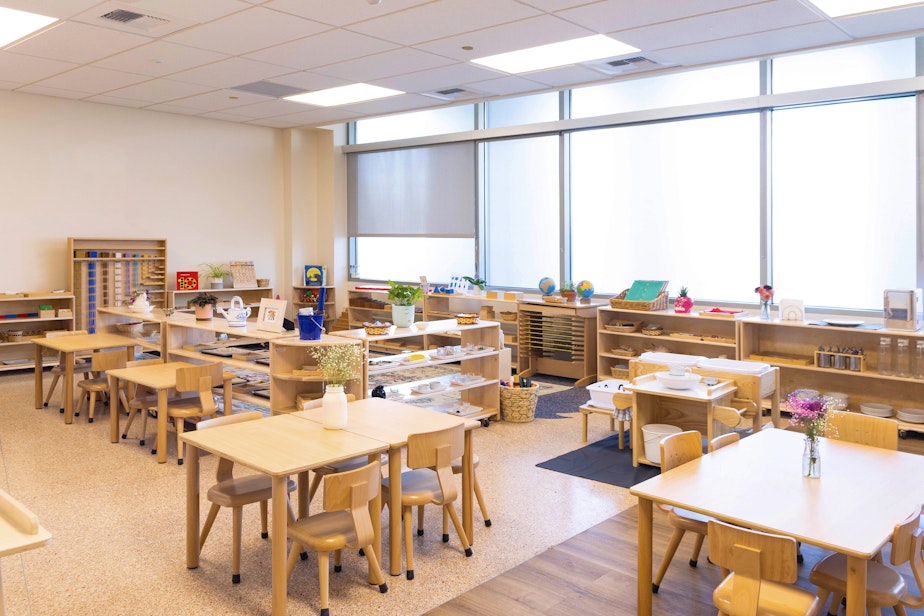How should Seattle look? Like art?: Today So Far

In his most recent Words in Review, KUOW's Bill Radke asks us to consider: Should Seattle be a work of art? He explores this question in a conversation with The Stranger's Charles Mudede.
This post originally appeared in KUOW's Today So Far newsletter for March 14, 2023.
Reader beware: Today's newsletter might make some folks irate.
There are two buildings in Seattle, right next to each other. One building is nearly 100 years old and looks far more aesthetically pleasing than most any building going up in Seattle today. The location next to it appears much newer, and mostly matches the architectural stylings of modern Seattle. Given the choice, I would live in the old building — likely lacking any modern conveniences — largely because of the aesthetic living environment it offers. I would find its neighbor rather stale and depressing.
But I can't live in either of these buildings, and not because they are located in pricey South Lake Union. These buildings are Public Storage facilities, located on Fairview Avenue, and one of them appears more appealing to live in than most any new housing units in town. It should probably say something, too, that a modern storage warehouse provides the same aesthetic impression as a newer apartment building. Seriously, look at this building, and then this one, or whatever the heck this thing is.
In his most recent Words in Review, KUOW's Bill Radke asks us to consider: Should Seattle be a work of art? He explores this question in a conversation with The Stranger's Charles Mudede, who recently commented to the New York Times about Seattle's bland appearance these days. It's refreshing because, for once, it's not just me giving the city a hard time for its lack of taste. While I have tried to avoid pointing too many fingers around Seattle, Mudede has no problem calling out the Urbana in Ballard as an example of a "monstrosity."
"I’ve even said, if the (design review) board was made of beavers, we would get a better building than what we have in Ballard. The Urbana is stunningly, I mean, it is the ground zero of all that you could imagine … in a city where, you know, we live together, we should be a little more cosmopolitan, right? We should have a little more taste, right? Flair! When you look at that building, you think, 'My goodness!'"
Sponsored
The thing about the Urbana is that it is efficient and serves its purpose, which is what a lot of people are arguing for in Seattle. This argument is why I figure today's newsletter will rub people the wrong way. There is a divide around the city when it comes to housing. It's probably safe to say most everyone agrees that more housing, and affordable housing at that, is needed. Among that agreement is the "tsk tsk" crowd when it comes the appearance of the city, which is pretty snobby. And then there is the "We desperately need housing now! Build like the wind! Down with NIMBYs!" crowd, which can also be pretty snobby. And honestly, Seattle, no matter where you land on this spectrum, a lot folks seem to speak up any time a change is proposed for their corner of the city, despite an awareness more housing is needed — admit it.
Our state will need more than 1 million homes over the next couple decades. Being the economic engine that it is, Seattle is at the center of this. This need is also emerging as the region faces severe homelessness. It is understandable that someone could get a little miffed when a critic (including the minimally educated like myself) comes along and says that housing looks bad. "Who cares what it looks like?! We desperately need to house people!" But this is a false option, according to Mudede.
"I do believe that housing and art do not have to be separated," Mudede told Radke.
"I am for aesthetics. Some of the stuff that's come out of the (city's) review boards cannot be looked at. Come on, when I use the word 'abomination,' I'm serious."
Environment matters. Aesthetics matter. Consider motorcycles. BMW motorcycles of the 1950s through about the 1970s looked pretty cool. You'd feel pretty cool riding on one. Today, however, I would not use the word "cool" to describe them (sorry BMW). "Efficient," sure. "Well-engineered," obviously. They're great for lengthy, rambling road trips, but not so much for instilling a sense of "this motorcyclist is happening." A similar sentiment could be said for many modern apartment buildings. A 2010 Gallup / Knight Foundation survey found that "social offerings, openness, and aesthetics" contributed most to a feeling of attachment in a community. It wasn't one issue or another. The University of Washington has also found that our everyday environment can influence our mental health. There is a value for everyone in our surroundings.
Sponsored
Beauty is subjective. Aesthetics are subjective. We can look at a painting and just see shapes, while Tom Haverford gets emotional. Mudede and I could probably walk around Seattle and agree and disagree on what looks nice and pleasing. An architect might come along and tell us we're both wrong. But most folks can likely settle on what doesn't appeal, so you'd think this could at least be a starting point for us. While I would agree the Urbana may miss the mark, it appears that someone at least put forth an effort to make it somewhat palatable (despite some of its paint). It's not like the Centerline in Roosevelt, or the Janus Apartments in Greenwood, or the Epicenter Apartments in Fremont (Tom Haverford would probably like the Epicenter). All of these buildings are efficient and put a roof over many people's heads. Yet, it's as if there is a karmic effort to make modern residents appreciate the Seattle box.
I know a lot of intelligent thought and effort went into many of these new structures around Seattle. I certainly don't have the skills to design them, yet a lot of these new buildings look like they came in a box with an L wrench. Such buildings say a lot, like: "One housing unit adequate for storage of one human unit." The end result are buildings that could be planted in any city and relate very little to the ambiance and history of the Northwest. Welcome to Anycity, USA.
Mudede has previously argued that Seattle has never really had visually appealing buildings to begin with. I would disagree while admiring certain warehouses (or perhaps Seattle's newer buildings make 100-year-old storage facilities look awesome by comparison). Most folks in our region would say that we need more housing. Ignoring this need will only exacerbate the problems we currently face. Perhaps more corners of the city would get on board with that effort if some art was put into the end result.
By now, it's possible I've run afoul of housing advocates, BMW motorcycle enthusiasts, architects, various apartment buildings, design review boards, and Seattle box admirers (though, personally, I don't mind a nice Seattle box house). I should probably set aside some time to deal with the emails...
Check out Bill Radke's full discussion around the question: "Should Seattle be a work of art?" Feel free to drop him an email with your own answer at bradke@kuow.org.
Sponsored
AS SEEN ON KUOW

A new tuition-free Montessori-inspired preschool is open in downtown Everett, backed by Amazon founder Jeff Bezos. It’s called Bezos Academy. The school offers year-round Montessori-inspired education to children ages 3-5 years old, five days a week. (Bassetti Archetects)
DID YOU KNOW?: Happy Pi Day!
Today is "Pi Day," in celebration of the important mathematical constant. Pi is 3.14, and today is March 14 (3/14), so you get the idea.
Sponsored
The celebration was invented by physicist Larry Shaw in 1988. Shaw worked at San Francisco's science museum, the Exploratorium. He initially organized a group of staff to march around a circular part of the building before eating fruit pies. In 2009, Congress passed a resolution stating that March 14 was National Pi Day. How, where, and when Pi was originally discovered has been lost to time. It showed up on clay tablets in Babylon (1900 BC) and in ancient records in Egypt (1650 BC). It was very well recorded by the Greeks.
I think this is a great excuse to go eat a cherry pie. Happy Pi Day everybody!
ALSO ON OUR MINDS

Sponsored
The Federal Reserve's fight against inflation just got harder. The high-profile collapse of two regional banks in recent days has sparked new fears about the country's banking system and raised questions about how much higher the Fed should push interest rates in its effort to curb prices.

